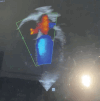Uncommon yet critical: Pulmonary embolism in a 14-year-old Nigerian child: A case report
- PMID: 39287263
- PMCID: PMC11404869
- DOI: 10.1097/MD.0000000000039503
Uncommon yet critical: Pulmonary embolism in a 14-year-old Nigerian child: A case report
Abstract
Rationale: Pulmonary embolism is a rare life-threatening condition in pediatric populations. Diagnosis is often challenging in resource-constrained settings suffering chronic shortages of specialist and diagnostic services. We report the prompt recognition and challenging management of pulmonary embolism in an adolescent presenting to a private specialist hospital in a resource-constrained country. Although, majority of the Nigerian population utilize private healthcare, most centers are not equipped with sophisticated radiological and advanced laboratory services. These services were outsourced to a recently equipped state-owned tertiary hospital.
Patients concerns: We present the case of a 14-year-old female who presented to the hospital with complaints of sharp left-sided chest pain and palpitations of 1 week duration. She was well until a week prior to the presentation when she noticed a sharp pain in her chest on waking up that was severe enough to make her cry. She was also felt her heart racing fast. The chest pain seemed to have subsided until a day prior to hospital presentation when she had a repeat episode following dance practice, necessitating her coming to the hospital.On examination at presentation, she was in painful distress, mildly pale, anicteric, acyanosed, with no peripheral edema. She had tachycardia, and her pulse was full volume, regularly irregular, and synchronous with peripheral pulses. Her blood pressure was 110/70 mmHg, and her apex beat was at the 5th left intercostal space, mid-clavicular line, non-heaving. Heart sounds 1 and 2 only were heard. The diagnosis was confirmed using a D-dimer assay, Echocardiography, and Computerized tomography pulmonary angiogram.
Diagnosis: A diagnosis of pulmonary embolism was made.
Interventions: The patient received pharmacological management using low molecular weight heparin, recombinant tissue plasminogen activator, and direct factor Xa inhibitor to manage and resolve the embolism.
Outcomes: The embolus was resolved after months of anticoagulant therapy, as confirmed by serial echocardiography.
Lessons: The case highlights the need for low-resource settings to address diagnostic limitations and emphasizes the importance of a multidisciplinary approach to managing pulmonary embolism cases. It also adds to the growing evidence of the effective role of pharmacological therapy in the management of pulmonary embolism.
Copyright © 2024 the Author(s). Published by Wolters Kluwer Health, Inc.
Conflict of interest statement
The authors have no funding and conflicts of interest to disclose.
Figures





References
-
- Navanandan N, Stein J, Mistry RD. Pulmonary embolism in children. Pediatr Emerg Care. 2019;35:143–51. - PubMed
-
- Van Ommen CH, Heijboer H, Buller HR, Hirasing RA, Heijmans HS, Peters M. Venous thromboembolism in childhood: a prospective two-year registry in the Netherlands. J Pediatr. 2001;139:676–81. - PubMed
-
- Buck JR, Robert H, Connors RH, et al. . Pulmonary embolism in children. J Pediatr Surg. 1986;16:385–91. - PubMed
Publication types
MeSH terms
Substances
LinkOut - more resources
Full Text Sources
Medical
Miscellaneous

